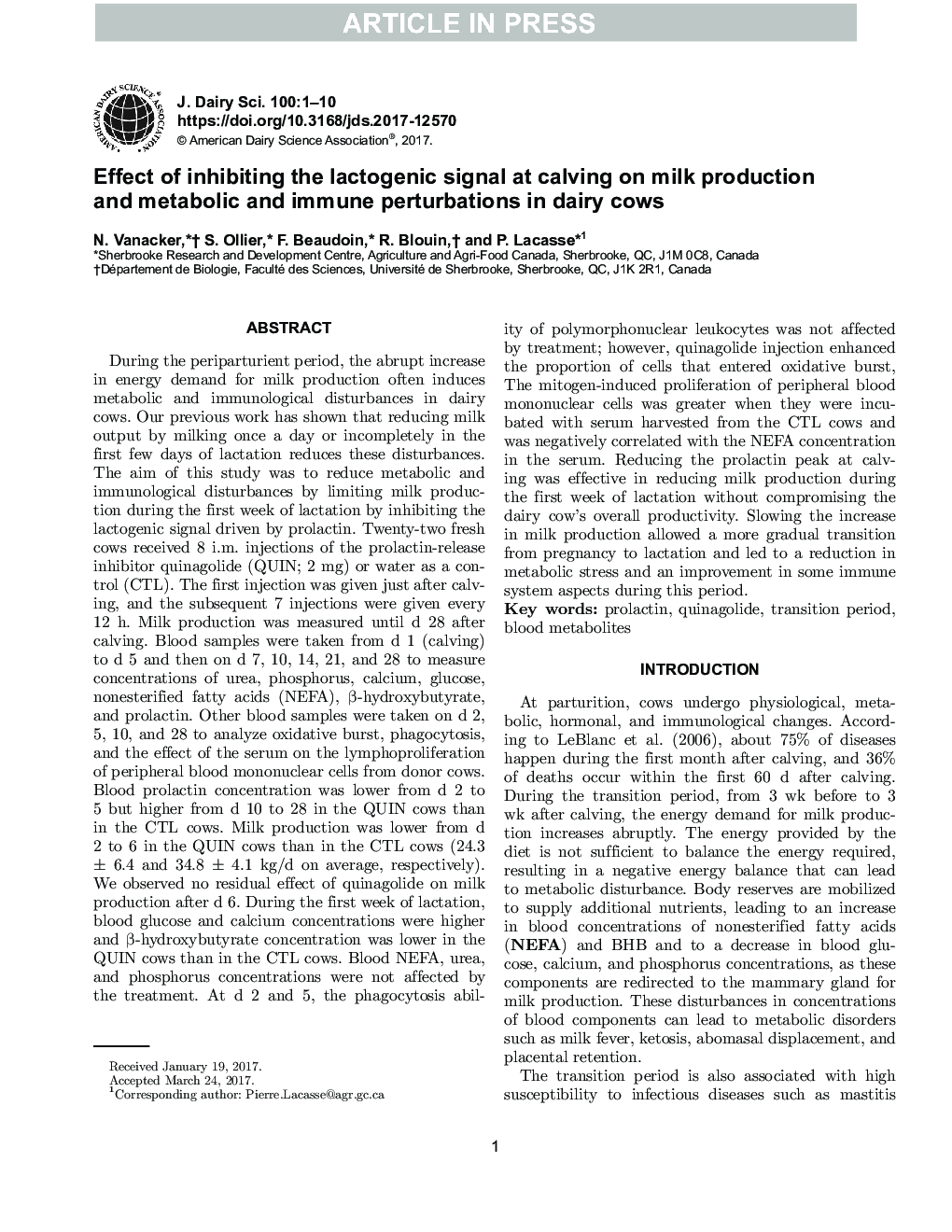| کد مقاله | کد نشریه | سال انتشار | مقاله انگلیسی | نسخه تمام متن |
|---|---|---|---|---|
| 5541780 | 1402510 | 2017 | 10 صفحه PDF | دانلود رایگان |
عنوان انگلیسی مقاله ISI
Effect of inhibiting the lactogenic signal at calving on milk production and metabolic and immune perturbations in dairy cows
ترجمه فارسی عنوان
اثر مهار سیگنال لاکتوژنیک در زایمان بر تولید شیر و متابولیسم و اختلالات ایمنی در گاوهای شیری
دانلود مقاله + سفارش ترجمه
دانلود مقاله ISI انگلیسی
رایگان برای ایرانیان
کلمات کلیدی
موضوعات مرتبط
علوم زیستی و بیوفناوری
علوم کشاورزی و بیولوژیک
علوم دامی و جانورشناسی
چکیده انگلیسی
During the periparturient period, the abrupt increase in energy demand for milk production often induces metabolic and immunological disturbances in dairy cows. Our previous work has shown that reducing milk output by milking once a day or incompletely in the first few days of lactation reduces these disturbances. The aim of this study was to reduce metabolic and immunological disturbances by limiting milk production during the first week of lactation by inhibiting the lactogenic signal driven by prolactin. Twenty-two fresh cows received 8 i.m. injections of the prolactin-release inhibitor quinagolide (QUIN; 2 mg) or water as a control (CTL). The first injection was given just after calving, and the subsequent 7 injections were given every 12 h. Milk production was measured until d 28 after calving. Blood samples were taken from d 1 (calving) to d 5 and then on d 7, 10, 14, 21, and 28 to measure concentrations of urea, phosphorus, calcium, glucose, nonesterified fatty acids (NEFA), β-hydroxybutyrate, and prolactin. Other blood samples were taken on d 2, 5, 10, and 28 to analyze oxidative burst, phagocytosis, and the effect of the serum on the lymphoproliferation of peripheral blood mononuclear cells from donor cows. Blood prolactin concentration was lower from d 2 to 5 but higher from d 10 to 28 in the QUIN cows than in the CTL cows. Milk production was lower from d 2 to 6 in the QUIN cows than in the CTL cows (24.3 ± 6.4 and 34.8 ± 4.1 kg/d on average, respectively). We observed no residual effect of quinagolide on milk production after d 6. During the first week of lactation, blood glucose and calcium concentrations were higher and β-hydroxybutyrate concentration was lower in the QUIN cows than in the CTL cows. Blood NEFA, urea, and phosphorus concentrations were not affected by the treatment. At d 2 and 5, the phagocytosis ability of polymorphonuclear leukocytes was not affected by treatment; however, quinagolide injection enhanced the proportion of cells that entered oxidative burst, The mitogen-induced proliferation of peripheral blood mononuclear cells was greater when they were incubated with serum harvested from the CTL cows and was negatively correlated with the NEFA concentration in the serum. Reducing the prolactin peak at calving was effective in reducing milk production during the first week of lactation without compromising the dairy cow's overall productivity. Slowing the increase in milk production allowed a more gradual transition from pregnancy to lactation and led to a reduction in metabolic stress and an improvement in some immune system aspects during this period.
ناشر
Database: Elsevier - ScienceDirect (ساینس دایرکت)
Journal: Journal of Dairy Science - Volume 100, Issue 7, July 2017, Pages 5782-5791
Journal: Journal of Dairy Science - Volume 100, Issue 7, July 2017, Pages 5782-5791
نویسندگان
N. Vanacker, S. Ollier, F. Beaudoin, R. Blouin, P. Lacasse,
